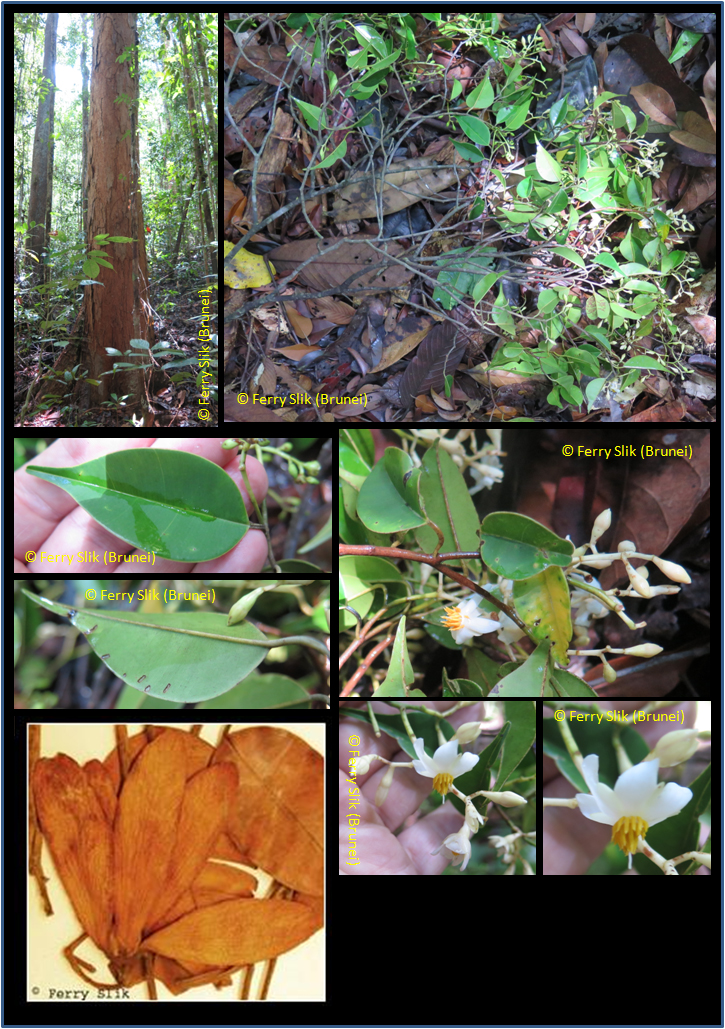Dryobalanops beccarii Dyer, J. Bot. 12 (1874)
Named after Odoardo Beccarii [1843-1920], an Italian explorer.Synonyms
Dryobalanops beccariana Ridl.
Dryobalanops oiocarpa Sloot.
Dryobalanops oocarpa Sloot.
Diagnostics
Emergent trees up to 57 m tall and 160 cm dbh. Stem with resin. Stipules up
to ca. 7 mm long. Leaves alternate, simple, penni-veined, secondary veins very
close together. Flowers ca. 25 mm in diameter, white, placed in panicles. Fruits
ca. 19 mm long, green-yellow-reddish, with five wings of ca. 65 mm long placed
on the calyx cup, wind dispersed.
Description
Emergent trees up to 57 m tall and 160 cm dbh. Stem with resin. Young parts sometimes fugaceous
puberulent, all parts otherwise entirely glabrous. Twig to 1 mm apically, slender, smooth. Bud 3-4 by
2 mm, narrowly lanceolate, compressed. Stipule 5-8 mm long, linear, fugaceous. Leaves 5-8 by 1-3 cm,
ovate to lanceolate, comparatively thin, base cuneate, acumen to 17 mm long, narrow, margin frequently
undulate; petiole 0.7-1 cm long, very slender. Panicle to 10 cm long, terminal or axillary, terete,
wrinkled on drying, irregularly doubly branched; bracteoles and bracts small, linear, fugaceous.
Flower bud to 10 by 3.5 mm, fusiform, acute. Sepals glabrous, equal, narrowly deltoid, subacute.
Corolla white; petals large, broadly elliptic, obtuse, glabrous. Stamens c. 30. subequal, almost 2/3
length of style; filaments united in a tube around the base of the ovary, the tube almost half as
long as the anthers; anther narrowly oblong, the cells tapering, acute; appendage to connective short,
erect, slightly exceeding anther. Ovary ovoid, glabrous; style 2-3 times as long as ovary, filiform,
glabrous. Fruit calyx glabrous; base with to 8 mm diameter, shallow or to 5 mm deep cup, unconstricted
at the rim, tapering gradually and cuneate at the pedicel; lobes equal, to 6.5 by 0.8 cm, glabrous,
oblong-spatulate, narrow, subacute, to 2 mm broad at the base, very thin and opaque between the
reticulations of the nerves. Nut to 1.4 cm long and diameter, ovoid to globose, glabrous, with
acute style remnant, resting on the considerably narrower calyx cup and pushing the lobes out to a
wide angle. [from Flora Malesiana]
Ecology
In undisturbed mixed dipterocarp forests up to 700 m altitude. On hillsides
and ridges with sandy soils.
Uses
The timber is used.
Distribution
Borneo.
Local names
Borneo: Kapur, Kapur keladan, Kapur merah, Kapur paji, Kapur ranggi, Keladan.
